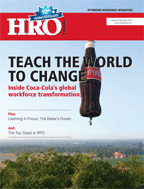 Inside Coke’s multiyear, multicountry rollout. It’s the real thing.
Inside Coke’s multiyear, multicountry rollout. It’s the real thing.
By Rich Litner and Lester Levine
As companies make strategic choices on the delivery of human resources (HR) services—whether to insource, outsource, or co-source—change management has been well documented as a success factor in HR business process outsourcing (BPO). Despite this, the strategic tactics for complex global implementations are less well known. A recent project at The Coca-Cola Company that had an expansive global footprint of 102 countries, including global service center support from Aon Hewitt (then Hewitt), provides a blueprint for successful change management.
The Coca-Cola Company began insourcing North America HR operations to shared services in 2001 and gradually added some international operations as opportunities presented themselves during the subsequent eight years. The joint BPO project began in May of 2009. The overall scope for outsourcing/insourcing was divided as such:
• Insourced: Benefits, compensation, employee relations, employee
separation, talent acquisition, learning and development, mobility, payroll, performance, and time and attendance.
• Outsourced to Aon Hewitt: Family and Medical Leave Act (FMLA),
health and wellness benefits administration and short-term disability (North America only), learning administration, new hire integration, performance management administration, talent acquisition administration, workforce administration.
The decision on what to insource and what to outsource was based on a detailed analysis of what would be both more effective and more efficient in the existing shared services operation versus Aon Hewitt.
Rolling Waves
Due to its complex, global nature, implementation was not executed as a big bang approach. Rather, it was rolled out in multiple waves:
Wave 1, March 2010:
• Established contact center and transitioned all outsourced services
listed above for North and Latin America to Aon Hewitt
• Involved 20 countries and took approximately 10 months
Wave 2, July 2010:
• Established contact centers and transitioned outsourced services in
Europe and Eurasia/Africa groups to Aon Hewitt
• Introduced online transaction processing for workforce
administration for North and Latin America with back-office support services provided by Aon Hewitt
• Involved 89 countries and took five months
• Leveraged learnings from Wave 1
Wave 3, October 2010:
• Established contact centers and transitioned outsourced services for
Asia-Pacific group to Aon Hewitt
• Involved 13 countries and took three months
• Leveraged learnings from prior waves
Wave 4, May 2011:
• Introduced online workforce administration transaction processing
for Europe, Asia, and Africa, with back-office support services provided by Aon Hewitt
• Introduced additional workforce administration online transaction
processing for North and Latin America with back-office support services provided by Aon Hewitt
• Involved 102 countries and took six months
• Leveraged learnings from prior waves
Change Management
With such a massive undertaking, The Coca-Cola Company and Aon Hewitt partnered on a change management plan that was designed and scaled to handle a multiyear, staggered, global HR BPO rollout. Key focus areas included identifying impacts of change for groups, businesses, and geographies; planning and deploying communications and training; and engaging the support of leaders and employees.
The change management operational structure and scale reflected both the partnership and the global challenge (see Figure 1).
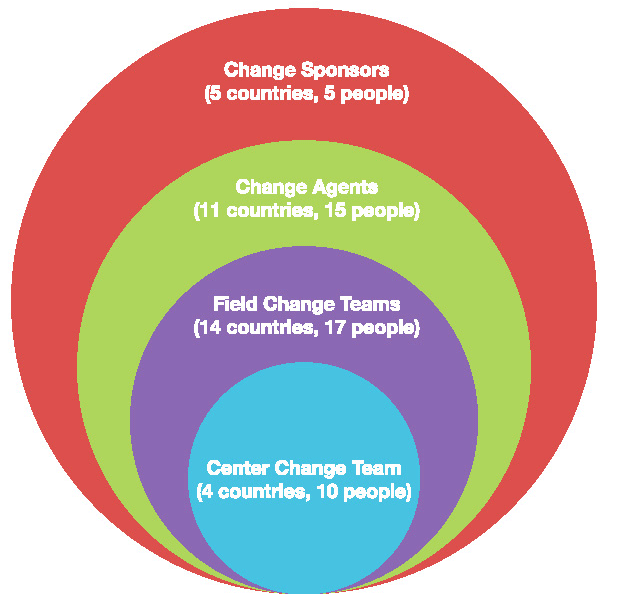
• Center Change Team. Composed of experienced management,
consisting of sub-teams from both partners with clearly defined roles and ownership for specific deliverables (e.g. change impacts, communications, training).
• Field Change Teams. Senior HR business partners from all five
global regions led variously sized teams (one to four change management personnel per team).
• Change Agents. Global business executives advise the extended
change team (Center and Field) regarding change risks, strategy, and issues.
• Change Sponsors. Business unit presidents provide change
leadership via visible show of support, feedback on key recommendations, and resource allocation.
The Rollout
Managing the rollout even with such a rigorous structure was not without its challenges.
The following four key takeaways can be applied to any global BPO effort.
Takeaway 1: Build and empower a comprehensive extended change team.
Many large-scale HR BPO implementations require an extended change team, typically organized by business unit. Organizations usually roll out centralized communications and training, and report on any local readiness issues.
With a complex, global project, an extended team becomes dramatically more important because local differences that could potentially affect service and adoption can be much more difficult to predict. The extended team needs to be empowered to tailor centralized change management tools and have the authority to implement their own practices to troubleshoot while staying true to the overall program.
Beyond understanding local differences, the extended team brings knowledge of regional culture that helps the interventions be more powerful. For example, the Latin American field change team recognized after initial planning using a contact center would be a departure for a region where people pride themselves on social, face-to-face interactions to do business.
At their suggestion, unlike webinars and emails used in North America to help prepare managers, they communicated the change with a previously unplanned deliverable. That deliverable was an in-person training session that the field team could deliver business unit by business unit. This really helped overcome initial discomfort with phone/online transactions. As a senior marketing manager for The Coca-Cola Company in Argentina summed up when he learned about online checklists and phone services to support transactions, “It was easy and the support was very good.”
Another example involved designing training for the Asia Pacific HR shared services organization to interact with Aon Hewitt.
This was the last region to transition, and the center change team intended to use the same approach that was successful in other the geographies. However, the field change team recognized that training approach which catered well to Western learning styles might not necessarily be the most effective approach for Asian cultures. The previous execution was a teacher-centered classroom environment with a large amount of open discussion and Q&A. So classroom training was changed to a period of self-study combined with private consultations with key subject-matter experts. Philip Sweeny, the head of HR shared services in Asia, notes the approach “proved to be very effective since it allowed for employees to read on their own [and] raise questions with a subject-matter expert (SME) in a more private context.”
With an empowered, extended team, open communication with the center team became critical to ensure consistency and relevancy of end deliverables. Weekly calls were held between each field team and the center team, as well as a biweekly forum for all field and center change team members.
Takeaway 2: Carefully differentiate change impacts for global and cultural differences.
While most global HR BPO projects aim to streamline processes as much as possible, there are many global differences in laws, regulations, and business practices. Maturity is also a factor. There is often variation between current state and the harmonized future state—countries, business units, and regions may be differentially mature in HR practices.
Sometimes overlooked, terminology was also a consideration. For example, in North America it is typical to say that someone “stamps” a document, whereas in Asia the document is said to receive a “chop.”
The extended field change team played a critical role in bringing these differences to light by gathering all of the local impacts in their geographies using a toolkit provided by the center team. They identified many singular impacts that otherwise would have likely been missed and saved much time and travel costs. Here is one for Korea:
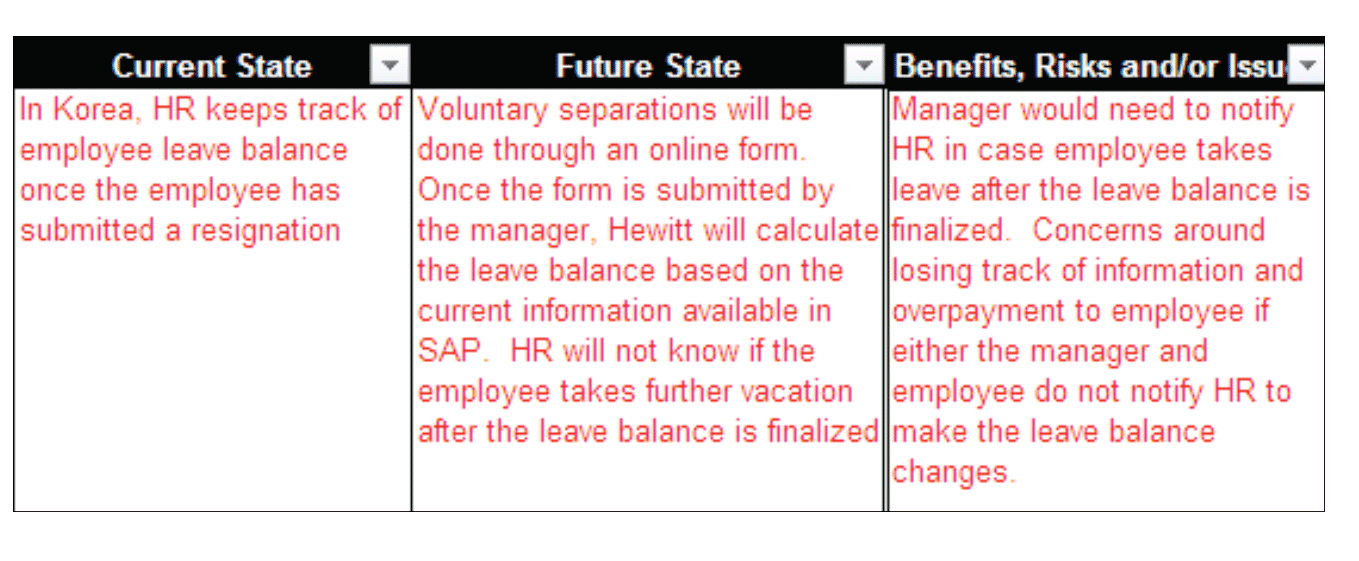
A more well-known change impact from moving to global HR BPO is language support.
The team knew early on for Asia-Pacific that there were several language hurdles.
• Phone menus are only available in English, Japanese, or Chinese.
• Employees who do not understand these languages will need to
know to hold for an operator. This was partially managed with a prompt for Korean, Bahasa, Thai, and Vietnamese assistance in their native language.
• To minimize frustration and engage the right translator, employees
need to be able to answer the following question in English: What language do you speak?
Kit Choi, HR director for The Coca-Cola Company in China and Korea, recalls “even with the different language prompts, we were challenged by plant employees coping with the language barrier. We translated materials into local languages, produced step-by-step reference guides on what to expect on calls, and conducted face-to-face training.”
Takeaway 3: Build once, but tweak more times in many ways.
While it is a best practice in most HR BPO implementations to use the same communications and training for all members of each stakeholder group (employees, managers, and HR professionals), occasionally an exception is needed to ensure maximum impact.
Successful tweaking stems from understanding how different cultures communicate, then customizing languages or formats around that approach. See Figure 2 for an example of the same communication that global teams in Asia and Europe tweaked to deliver the same content, but in a different format with different messages highlighted.
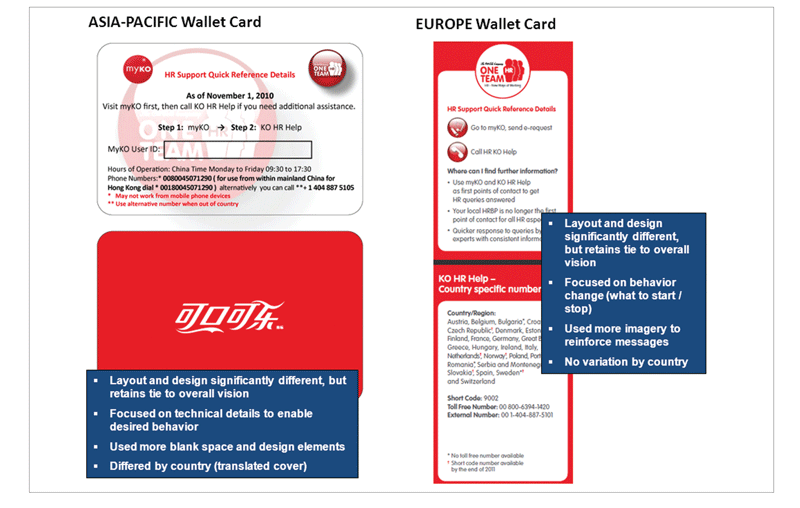
Sometimes these customizations are to the materials, other times, they could be the vehicles or the communicators themselves that change. For example, regional change agents presented key change information to their leadership. In a global effort, the benefits of this activity are very powerful: Change agents have a better ability to communicate because they can a) speak the same language and b) understand any cultural nuances needed in a face-to-face communication.
Likewise, in the aforementioned Latin American example, by having the field change team deliver the materials, the presenters could speak fluently in both English and Spanish—the latter often preferred and sometimes necessary to address nuanced questions.
Another customization could involve taking advantage of local themes or templates. During this project, South Africa hosted the first-ever World Cup on African soil. Many of the communications in Africa during 2010 reflected this momentous occasion, and HR BPO communications were no different.
With tweaking, one might be tempted to diffuse change management responsibility locally. However, with five global regions and 102 countries, scaling as much as possible provides a significant cost benefit. Even with these examples of tweaking, the team still developed more than 60 percent of the materials for consistency. The key in balancing the tweaking of materials and the cost to develop them is to coordinate global reuse on labor intensive efforts (e.g. video) and focus less on other (e.g. PowerPoint presentations). Clear roles and constant communication between the center and field change teams ensures no duplication of efforts.
Takeaway 4: Expand service rehearsal testing to ensure management of service and adoption risks.
Service rehearsal testing is a routine line item in HR BPO project plans. However, when dealing with the complexity of five contact centers, multiple support processes, and many region and country-specific process variations, such testing must be carefully expanded to avoid initial poor service perception and adoption at best, and a business disruption nightmare, at worst.
For example, as Steve Yohn of Aon Hewitt explains, “The service model for The Coca-Cola Company included a contact center in Shanghai, China, taking calls from Korea, China, Mongolia, Hong Kong, and Taiwan. Having the representatives handle scripted calls during service rehearsal and using the third-party translation service was a key driver to a successful transition. The different dialects between Hong Kong and mainland China alone are material, and the rehearsal period allowed representatives to gain knowledge of their tools while practicing client interactions—win-win.”
Trish Kozola of Aon Hewitt recalls learning that service reps would have to “… explain how to key in … associate ID that started with a letter, when calling from a cell phone that didn’t have a [U.S.] standard telephone keypad translation.” The rep would be responsible for knowing which letters corresponded with which numbers on a keypad—like the number six would represent MNO. This taught the team not to assume anything and to explain everything!”
HR BPO global complexities can be quite challenging. For example, transactions on employees located in a country differing from their manager create significant obstacles and barriers, including:
• Local labor laws that vary and constantly change. Remote
managers will not be aware of local nuances and will need support.
• The shared service center supporting the manager may not be
the same as the center supporting the employee—which can create additional complexity and frustration for a manager attempting to complete a transaction.
Service rehearsals can be a great way to highlight some of these complexities and engage the business in leading change. As Yohn notes, “During the rehearsal period for a centralized, North America-based center for North American and Latin American populations, a Spanish-speaking HR executive volunteered to make some test calls. He spoke to a U.S.-based, Spanish-speaking representative, and had an extremely positive experience. After that, he spread the word among his HR peers and Latin America-based client constituents that the change ‘was going to work!’—clearly, the hands-on experience helped confirm what the change communications had been saying.”
If the extended change team has access and input to a rehearsal script, then participating in the testing will give them a first-hand experience of how the process works and what changes should be implemented.
Going Forward
Change management doesn’t end with an implementation. The Coca-Cola Company and Aon Hewitt continue to partner in post-implementation change management and learn global HR BPO change management lessons as thousands of employees receive HR services.
Of course, tracking adoption is the ultimate test of change management success. At The Coca-Cola Company, adoption is monitored on an ongoing, global basis. For example, in talent management:
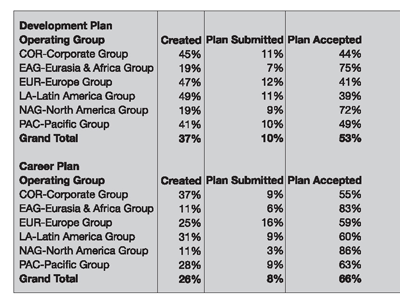
An early snapshot such as this enables targeted change interventions specific to the task and region/country. Adoption feedback also provides insight into how to adapt existing change interventions. Initially, the team produced six regional versions of an English-language job aid, each customized with country-specific information, vocabulary and spellings (e.g. organisation vs. organization) to help counter the perception of change being driven by the corporate center. After implementation, adoption feedback indicated that day-to-day reliance on these materials had decreased, allowing consolidation of the regional versions, thus simplifying maintenance going forward.
Change interventions also must evolve as strategic choices are made to improve the user experience of receiving HR services. “We continue to audit our procedures, tweak any differences, and simplify them over time,” says Kevin Shigley, HR director of talent acquisition for The Coca-Cola Company. “We continuously look for opportunities, pilot these improvements in smaller areas, learn from the pilots, and then drive that change across the business.” After all, going live is only the beginning of managing the path from change to a new “business as usual.”
DON’T OVERLOOK SIMPLE THINGS:
• Bandwidth Issues
When delivering streaming video, remember that Internet speeds and access to computers can vary widely across different parts of the world, so plan for different delivery systems. Some locations in Asia and Africa could not view some of the leadership videos that had been posted on the web and required CDs for face-to-face meetings instead.
• Geography-Specific Holidays or Events
What may be a holiday in one part of the world may not be in another. Assigning work to British team members to carry during the American Thanksgiving week provided an extra burst of productivity, while planning a go-live for May 1 in Europe presented significant challenges since much of Europe celebrates May Day.
• Telephone Numbers
Everything communicates. Sometimes having a phone number based in-country versus a number based in the corporate headquarters’ country can communicate the support of local leadership behind a change. Other times having a local number will allow for reduced charges from local mobile plans. Regardless, all of these factors must be considered when deciding how many different phone numbers to have and where those numbers will be. In the prior Asia-Pacific wallet card example, the team was careful to note when and where associates should use different numbers depending on whether they were on a mobile phone or in China, Hong Kong, or another part of the world.
• Government Rules and Regulations
For Europe, changes to organizations that impact associates legally must go through works councils, which can add significant time to project deployment. The works council must be treated as a separate stakeholder and be advised of communications prior to involving associates in work that could impact their positions.
• Terminology
What is a manager? The same term may mean very different things in China and Brazil. And sometimes the opposite is true—two different words can mean the same thing in different countries. Employees that “separated” from The Coca-Cola Company in the United States were called “leavers” in England, which in turn created challenges for the United States as an employee on “leave” is very different from an employee who leaves a company. Having an extended field team can help to highlight some of these differences. Sometimes it is important to speak multiple languages, even if that one language is English!
Rich Litner is a change management lead for The Coca-Cola Company and Lester Levine is change management lead for Aon Hewitt.













